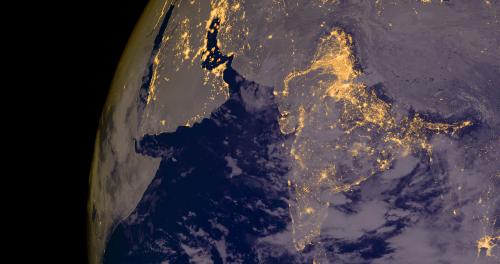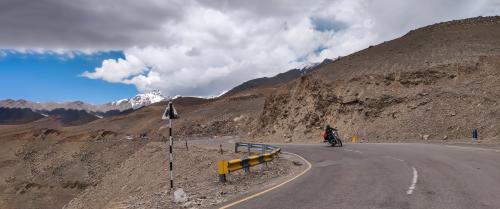Content from the Brookings Institution India Center is now archived. After seven years of an impactful partnership, as of September 11, 2020, Brookings India is now the Centre for Social and Economic Progress, an independent public policy institution based in India.
Sambandh Scholars Speak is a series of blog posts that feature evidence-based research on South Asia with a focus on regional studies and cross-border connectivity. The series engages with authors of recent books, articles, and reports on India and its neighbouring countries.
In the first of our blog series on issues related to India’s neighbourhood connectivity, Nidhi Varma interviews Mirza Zulfiqur Rahman, Visiting Research Associate, Institute of Chinese Studies, Delhi on his recent work in antiAtlas Journal “Informal Markets and Fuzzy Flows in Fragile Border Zones.”
Q: In your article,[1] you examine the differences between how fragile borders are perceived by states and residents, with a focus on the India-Bangladesh border. You say, ‘the borders of the state are reproduced through the structure of the market itself’. At the national level, the state views the border as a rigid and fixed one, while, at the local level, the border is a “mobile” one. How should a sovereign state deal with and define these “fuzzy frames”?
A:The challenges faced by the sovereign state in dealing and defining these ‘fuzzy frames’ have to be seen in context of the distinction between the perspectives concerning linear boundary markers/border fences, and of meandering borderlands. The official ‘border haats’ between India and Bangladesh are an excellent case in point, where you essentially require a border fence to be constructed first along specific border pillars, and then regulate the fence through gates, manned by the Border Security Force and the Indian Customs, opening up to a ‘border haat’ infrastructure. The informal markets, on the other hand, pre-date the formation of the modern nation-states of India and Bangladesh, and signify local networks of exchange, flow of goods, community interactions and negotiations across borders.
A fuzzy yet functional framing of the mobile border sits at the edges of the multiplicity of border layers, between state anxieties of control, authority and calculation of rigid fixed borders, and local community specificities inhabiting the meandering borderland spaces while fully recognising nation-state sovereignty. The official securitised ‘border haats’, are seen as rupturing traditional informal market spaces and cross-border community interactions, making for sensitive spaces, exclusionary permit and regulatory systems, in an otherwise bustling vibrant market space.
Q: You’ve studied the India-Bangladesh border in extensive detail, do you see any similarities in other border areas, such as along the India-Myanmar border, and the local exchange networks that are, for example, present in Manipur (Moreh)?
A: Yes, the entire India-Bangladesh border is interspersed with such networks of local exchanges, including in Assam and Tripura, India-Bhutan border in Assam and Arunachal Pradesh, India-Myanmar border in Arunachal Pradesh, Nagaland, Manipur and Mizoram. The fulcrum of such local exchange networks, does not rest alone along the international boundary line as we may commonly understand, but across internal borders and spaces within Northeast India and within local exchange networks of Bangladesh, Bhutan and Myanmar as well. Given the relatively smaller scale at which local networks of exchanges operates in these borderlands, the critical mass is generated within a framework of functional market linkages, production, traditional trading routes, inter-community relations, which converge at the international borders.
It is the selective focus and attention of the nation-state that makes border towns such as Moreh central to the imagination of connectivity between Northeast India and its proximate international neighbourhood. However, the imagination of borderland communities operates at multiple levels across the national and regional spaces, such as the Pangsau Pass (Stilwell Road) and Zimithang in Arunachal Pradesh, Lungwa in Nagaland and Champhai in Mizoram. Any regional connectivity architecture will have to factor in the multiplicity and convergence of local networks and routes.
Q: From your reading of the area, do local communities along the border of Meghalaya, given their shared history with cross-border communities, feel more closely aligned to the cultures of bordering Bangladesh than they do to the rest of India?
A: The local communities inhabiting these borderlands in Northeast India, to my mind, are uniquely positioned to serve as strong ‘cultural connectors’ in any future regional connectivity architecture within India’s neighbourhood diplomacy. I use the term ‘cultural connectors’ to describe cultural drivers at the borderlands which can contribute towards enhancing the content of public diplomacy by nation-states across international borders. Some examples of cultural drivers are ethnic commonalities and shared cultural worldviews and aspirations of connectivity across national and international borders. Cultural connectors lays emphasis on shared ‘soft’ cultural frames of reference as opposed to the ‘hard’ securitised and strategic frames of reference that usually define exchanges and interactions across nation-state borders.
The imagination and deployment of cultural connectors within the larger strategic and bilateral public diplomacy between nation-states act as alternative catalysts, and this holds true of India’s Look/Act East Diplomacy. A number of cultural connectors in Northeast India are waiting to be tapped by India’s neighbourhood diplomacy in an innovative manner. This is however been plagued by a historical reluctance to trust local actors and traditional patterns of governance in Northeast India by New Delhi to take an active part in India’s foreign policy decision-making, which needs rethinking.
Q: In the article, your use of images at/of the border as the central focus of the narrative is unique. Why was this element important for you to include? What can you tell us about the fieldwork involved for this project?
A: The use of images becomes critical in being able to convey the unique context and specificity of the borderlands and its communities. The images are deployed as metaphors to depict certain core themes, and enable the research study to make space for the contrasting perspectives on the market, for instance, by local communities and national actors and agencies. The images serve as characters by themselves and are interwoven in the article to lend context to the multiple spaces and actors and holds the narrative of the article together. It offers a visual ethnography of the borderland by positioning the view garnered of and by the local communities present in these market spaces, as well as of the exchanges that take place across national borders. Overall, the use of images provides a well-rounded methodological approach to border studies.
The fieldwork involved for this project involved several visits over successive years to the informal border markets, official ‘border haats’, and the villages and other market spaces around it. A lot was learnt from how the informal markets operated, of being able to navigate the multiple layers of control and authority, and being sensitive to local aspirations and their networks of trust.
 About the expert: Mirza Zulfiqur Rahman holds a PhD in Development Studies from the Department of Humanities and Social Sciences, Indian Institute of Technology (IIT), Guwahati, Assam. His areas of interests include research on Northeast India, mainly on issues relating to transboundary water sharing and hydropower dams, roads and connectivity infrastructures, conflict and insurgency, peace building, development politics, migration and cross border exchanges. His research specialisation is on border studies in Northeast India and transboundary water sharing and management issues between China, India and Bangladesh.
About the expert: Mirza Zulfiqur Rahman holds a PhD in Development Studies from the Department of Humanities and Social Sciences, Indian Institute of Technology (IIT), Guwahati, Assam. His areas of interests include research on Northeast India, mainly on issues relating to transboundary water sharing and hydropower dams, roads and connectivity infrastructures, conflict and insurgency, peace building, development politics, migration and cross border exchanges. His research specialisation is on border studies in Northeast India and transboundary water sharing and management issues between China, India and Bangladesh.
He is currently a Visiting Research Associate, Institute of Chinese Studies, Delhi. He can be contacted at [email protected].
Cover Photo Credit: Mirza Zulfiqur Rahman.
[1] Boyle, Edward and Rahman, Mirza Zulfiqur, “Informal Markets and Fuzzy Flows in Fragile Border Zones” in antiAtlas Journal #3 | 2019, online, URL: www.antiatlas-journal.net/03- informal-markets-and-fuzzy-flows-in-fragile-border-zones
The Brookings Institution is committed to quality, independence, and impact.
We are supported by a diverse array of funders. In line with our values and policies, each Brookings publication represents the sole views of its author(s).





Commentary
Fuzzy frames: Mobile borders versus rigid boundaries in India’s neighbourhood
March 20, 2020